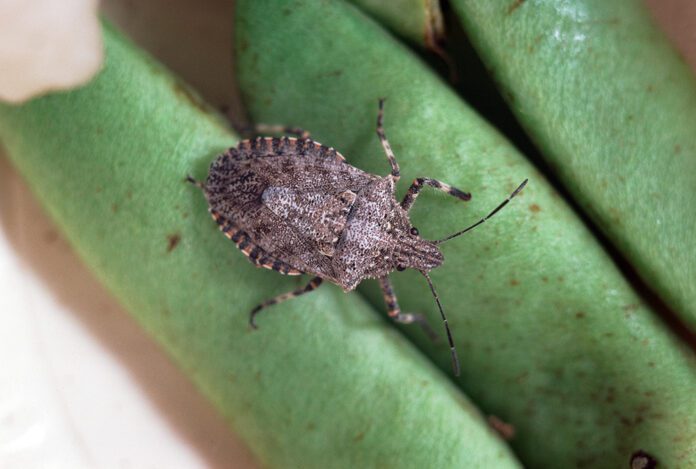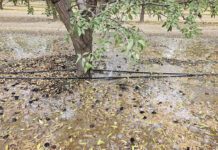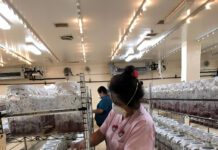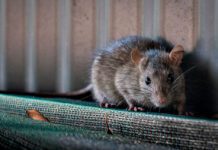
No longer secondary pests in orchards, large bug species that cause crop loss and damage are posing more challenges as tree nut growers strive to deliver a quality crop. Stink bugs and leaffooted bugs (LFB) were secondary pests in orchards. However, with the transition to softer chemistries, they have now become primary pests that cause damage directly to the fruit and crop loss.
Green stink bugs, brown marmorated stink bug (BMSB) and LFB are becoming serious problems for tree nut growers due to their broad host range, high mobility, ability to directly damage the crop, changes in chemical use and difficulty to control. Costs to monitor these pests and apply insecticides affect the bottom line.
The crop damage toll is found on processor grade sheets. Using their piercing-sucking mouth parts, these pests are inflicting both early season crop loss seen as nut drop and late-season kernel damage (brown spot) that shows up in processing. Lauren Fann, Almond Board’s senior pest management specialist, said these pests can cause crop damage in all mobile life stages.
Without effective lures or traps to determine if pest stink bugs are present in the orchard, damage levels in last year’s crop, presence of host plants near orchards and visual observation are recommended. The first step is correctly identifying the pest and hosts that might be boarding your orchard.
1. Identification
Adult LFB are the easiest to identify with their distinctive hind leg leaf structure. These hemipterans are large and easy to spot as adults, but when in the nymphal stage may be harder to identify. Nymph bodies can range in color from orange to reddish brown, and the leaf-like hind leg does not develop in the early instars. That changes in the late instars when their bodies change to a dark brown color. LFB eggs are laid in chains on branches, leaves or peduncles of host plants. This pest is found all over the Central Valley.
BMSB are identified by the white bands on antennae and legs. Adult bodies are about ¾ inch in length and brown. Nymphs are nearly the same shape but are wingless. The invasive BMSB is found mainly in the northern San Joaquin Valley.
Green stink bugs adults are bright green with yellow margins around the thorax and abdomen. Early instars are black and white with red bands. Later instars are green and black with some red coloration. Eggs are barrel-shaped and laid on the underside of leaves in a cluster.
UCCE IPM Specialist Jhalendra Rijal said these pest species should not be confused with the predatory rough stink bug, which is a faded grey or dull color and does not have mouthparts like the pest species. Close inspection of stink bugs shows their piercing stylet.
2. Phenology
The biological life cycles of pest stink bugs are important to recognize.
BMSB overwinter as adults in aggregations outside of orchards. They can be found in sheltered areas of buildings or debris piles or eucalyptus stands during the winter. When this pest emerges in the spring they mate and deposit eggs on the underside of the leaves of a host plant.
Adults are also looking for food sources, Fann said, and as nuts develop on the trees, they move from adjacent hosts into orchards. Rijal said feeding may begin at fruit set and can continue throughout the growing season with adults and nymphs present at the same time. Prior to shell hardening, the feeding is destructive, causing fruit drop. Feeding after shell hardening results in gumming and dark spots on the kernel. Pinholes, water-soaked lesions and necrotic spots are signs of internal feeding.
LFB also overwinter as adults, emerge from shelter in the spring and begin looking for food. They move into orchards as temperatures rise. LFB produce two generations per year. Rijal said the overwintering adults that move into orchards in the spring cause the most economic damage.
Green stink bugs do overwinter in orchards, then move into orchards during the summer. Populations are slow to increase.
3. Monitoring
If there is a history of stink bug or LFB damage in an orchard, Rijal recommends visual sampling for both stink bug life stages and damaged nuts. There are no commercially available lure/trap combinations for LFB or green stink bugs, but BMSB activity can be determined with a trap and lure that attracts both nymphs and adults. Rijal said these traps should be placed in the border row facing the most likely overwintering site.
Regular scouting for LFB should be done on the sunny side of the tree on edges to detect adults. They are often in higher branches. Stink bugs are highly mobile; adults are strong fliers and nymphs can walk long distances to get to food sources, Fann said. Gummosis, nut drop and cutting into nuts to see if they have been pierced by LFB or stink bug mouth parts is advised. Rijal said beat trays held under tree branches can be used to determine if stink bug populations are building in an orchard. There are no economic thresholds determined for stink bug numbers, but orchard history and signs of nut damage can be used to determine if control measures should be taken.
There is an aggregation pheromone lure for BMSB. It attracts all mobile life stages and can attract other species of stink bugs. UC researchers, including Professor of Entomology Jocelyn Millar and IPM Specialist Houston Wilson, have been working on a lure/trap combo for LFB.
4. Biological Control
Rijal said there are several predators and parasites in orchards that can keep bug numbers below a certain level. An egg parasite can keep LFB populations under control during the summer.
There are chewing, piercing and sucking insect species that prey on stink bugs. Rough stink bug, big eye bug and leafhopper assassin bug are among predators that attack pest stink bugs. Daddy long legs and lacewing larvae are also listed predators. Parasitoid wasps attack stink bug eggs. A list of additional natural enemies can be found on UC IPM’s natural enemies gallery.
Aside from predators, Fann noted management practices that can help cut down on pest populations. Removal of overwintering sites, including woodpiles and trees that harbor LFB and BMSB (eucalyptus, juniper, cypress and tree of heaven), is recommended.
5. Insecticide Control
Not having economic thresholds for damage by stink bugs and LFB makes it difficult to choose pesticide applications. By the time adult numbers build up, crop damage is likely to have already occurred.
Rijal recommends following the UC IPM guidelines for stink bug and LFB for specific insecticide rates and the potential impacting beneficial insect populations. If scouting shows LFB activity in the spring, a one-time spray may be effective. Overlapping generations of BMSB may require more applications.
For all true bugs, pyrethroids and neonicotinoids are considered effective but are likely to impact natural enemy populations.

Cecilia Parsons | Associate Editor
Cecilia Parsons has lived in the Central Valley community of Ducor since 1976, covering agriculture for numerous agricultural publications over the years. She has found and nurtured many wonderful and helpful contacts in the ag community, including the UCCE advisors, allowing for news coverage that focuses on the basics of food production.
She is always on the search for new ag topics that can help growers and processors in the San Joaquin Valley improve their bottom line.
In her free time, Cecilia rides her horse, Holly in ranch versatility shows and raises registered Shetland sheep which she exhibits at county and state fairs during the summer.















